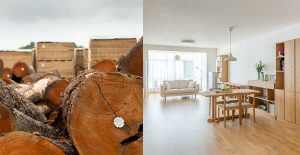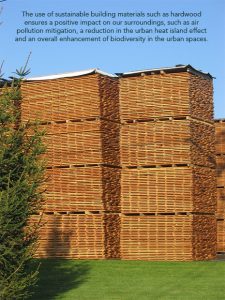It is no secret that timeless and elegant infrastructure can add matched beauty to any product. We, more than anyone, can appreciate the major role that good hardwood plays in this. But that’s not all that hardwood does. Hardwood species are, now more than ever, becoming an absolutely essential part of green urban infrastructure projects. Let’s take a look at the role hardwood plays to contribute to the creation of resilient green spaces in the urban spaces, and allows us to lead a more sustainable and green life.
The use of sustainable building materials such as hardwood ensures a positive impact on our surroundings, such as air pollution mitigation, a reduction in the urban heat island effect and an overall enhancement of biodiversity in the urban spaces. Anyone living in an urban city can probably attest to the need and importance of integrating green spaces in our regular urban environments. Green urban infrastructure refers to spaces such as parks, gardens, roof gardens and the general practice of building infrastructure facilities in a more sustainable and green manner.

Being one of the only renewable and recyclable building materials, hardwood adds a ton of benefits to urban spaces, along with unmatched elegance. A quick look at the use of hardwood in Japanese and Scandinavian infrastructure can attest to this. Hardwood also absorbs harmful substances, such as carbon emissions, thus reducing the overall air pollution and elevating the quality of life. For those living in colder regions, hardwood also acts as a great insulant.
Hardwood is a great addition to infrastructure projects, not only because it is biodegradable and organic, but also due to its ability to facilitate a positive environment, thus helping immensely with mental health as well. By harnessing the qualities of hardwood for creating green urban infrastructure projects, we can create spaces which not only lower our collective carbon footprint, but also provide a beautiful urban landscape which allows us to connect with nature.

Incorporating wood into our surroundings can, furthermore, increase the overall quality of life by enhancing mental health, lowering stress and helping people connect with the environment, thus also improving overall productivity. By integrating hardwood elements into streetscapes, plazas, and public buildings, cities can create more human-centric spaces that promote health, happiness, and a sense of belonging.
Hardwood stands as a cornerstone of urban infrastructure, offering a harmonious blend of strength, sustainability, aesthetics, and economic viability through its properties of longevity and durability. Therefore, in order to ensure healthy and green living spaces, we must embrace the use of hardwood in developing green urban infrastructure.


